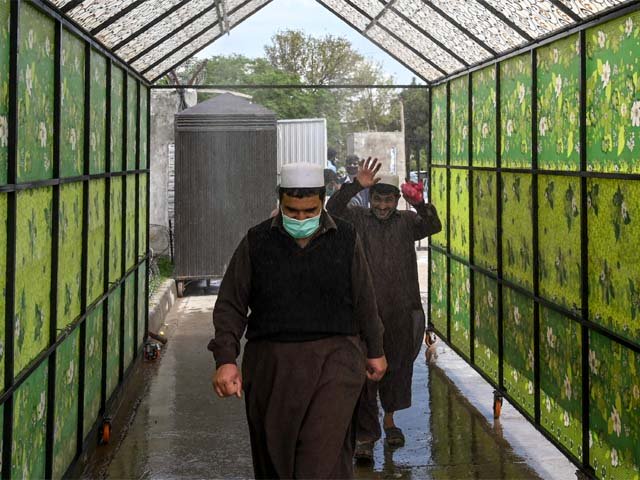
Residents wearing face masks walk through a disinfecting tunnel in Islamabad. PHOTO: AFP
How effective are walk-through disinfection gates against Covid-19?
Personnel disinfecting tunnels which lack standardisation may provide a false sense of protection
The Covid-19 pandemic has resulted in a myriad of interventions aimed at preventing further cross infections. The ones that have been proven to be effective from a public health perspective include detect, trace, isolate or quarantine, respiratory etiquette, hand hygiene and disinfection of high touch surfaces. Physical distancing is also imperative, especially for protecting those vulnerable individuals with underlying illnesses like diabetes mellitus, hypertension, or heart disease and those who are immunocompromised. Gates for spraying diluted disinfectants, whether chlorine based or with chlorxylenol, on people entering certain premises have also been installed in certain localities in Pakistan. According to an official belonging to the Capital Development Authority (CDA),
“Although we do not have scientific evidence about how effective they are against Covid-19, it is a fact that such sprays kill germs and can protect people from diseases.”
But exactly how effective are these walk-through gates?
Covid-19 is a respiratory virus spread via respiratory droplets from infected individuals or by touching surfaces likely to harbour these infectious droplets, known as “high touch surfaces”. This reinforces the need for hand hygiene and respiratory etiquette combined with physical distancing, wearing of face masks and the disinfection of high touch surfaces. Naturally one’s clothing would not be a high touch surface for others in office environments or public places and, even if someone is in the asymptomatic phase, they are less likely to spread the virus if they are not coughing or sneezing. A one time spray on a person who is infected will not clear the virus from their respiratory tract. Disinfectants that are safe to use on skin are labelled as antiseptics, and while all antiseptics are disinfectants, all disinfectants are not antiseptics. For instance, bleach is not an antiseptic.
Chlorine based products can be irritants and they are used in certain dilutions for various purposes including disinfection of high touch surfaces, or to clear up blood/bodily fluid spills. Another scenario which has been proposed by some is the passage of vehicles through disinfectant showers. However, a more logical approach is wiping down high touch surfaces of vehicles with a chlorine based disinfectant. Alcohol should not be used for large surface areas as it is flammable, while methanol is extremely toxic.
Hand washing with soap for at least twenty seconds or using an alcohol based hand sanitiser is the primary preventative measure to help cut down on cross infections. Therefore, spraying people with disinfectants is not a logical approach since hands contaminated with respiratory secretions are likely to transfer the infectious virus to high touch surfaces and an individuals clothes are not likely to be a high touch surface for others. Hence, hand hygiene and regular disinfection of high touch surfaces cannot be substituted by poorly standardised disinfection showers because of the type of disinfectant used and its contact time on the body or clothes. Moreover, these chemicals can be irritants for the eyes and mucous membranes since they are meant for inanimate surfaces.
A multi-pronged approach using hand hygiene, high touch surface disinfection and maintaining a physical distance as precautionary measures is the best approach. Disinfecting surfaces or areas which are not high touch surfaces like roads is not particularity effective in combating this virus and will only lead to a loss of work hours and resources. The World Health Organisation (WHO) clearly endorses the fact that spraying alcohol or chlorine over one’s body will not kill viruses that have already entered the body. Furthermore, the spraying of chlorine based disinfectants on people can lead to skin and eye irritation and can also have gastrointestinal effects such as nausea and vomiting, respiratory tract irritation and even brochospasm.
Another concern is mixing bleach with other disinfectants, which can have a disastrous effect. Bleach should not be mixed with alcohol as this can lead to the formation of chloroform which is a probable carcinogen. Bleach should not be mixed with water that has a high organic content (unclean water) because that too can lead to chloroform formation. From a technical perspective, a bleach or sodium hypochlorite is a potent oxidising agent which dissipates in side reactions so rapidly that little disinfection is accomplished when it is neutralised by dirt, and it works only on surfaces without organic materials. Hence, personnel disinfection tunnels which lack standardisation may provide a false sense of protection and could undermine the evidence based coronavirus preventive measures like adequate hand hygiene, high touch surface disinfection and physical distancing.

COMMENTS
Comments are moderated and generally will be posted if they are on-topic and not abusive.
For more information, please see our Comments FAQ